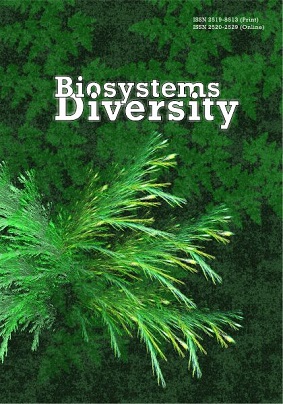Radial increment in European spruce (Picea abies) as indicator of sanitary condition of spruce forests in the Ukrainian Carpathians
Radial increment in European spruce (Picea abies) as indicator of sanitary condition of spruce forests in the Ukrainian Carpathians
Author(s): N. F. Prykhodko, M. M. Prykhodko, T. V. ParpanSubject(s): Agriculture, Energy and Environmental Studies, Recent History (1900 till today), Sociobiology
Published by: Дніпропетровський національний університет імені Олеся Гончара
Keywords: individual growth ring chronologies; generalized growth ring chronologies; index of radial increment; increment of abnormality of radial increment; cycles of radial increment;
Summary/Abstract: In recent years, there has been an intense desiccation of spruce forests in the Ukrainian Carpathians, where European spruce is the main forest-forming species. Over the recent years, desiccation has spread to the spruce forest stands which grow in the Carpathians at the height of over 1,000 m above the sea level. This process causes large economic losses, significant deterioration of the condition and productivity of the forests in the Carpathians, decrease in the level of provision of ecosystemic services by forests, functions they perform, therefore leading to dangerous exogenic processes (floods, freshets, erosion, mudflows, landslides). To determine the interaction between the radial increment and sanitary condition of the spruce stands and substantiate the measures of the use of drying spruce forests, in the Vysokohirsky forestry reserve district of the Ukrainian Carpathians in anti-erosion forests, in hotbeds of desiccation of spruce in 2018, dendrochronological surveys were undertaken in two monitoring plots in forests in weak and severely weakened condition. We collected cores from the model trees, measured width of the annual rings, and developed individual dendrochronologies according to the absolute values of the radial increments and generalized dendrochronologies according to the absolute values of the radial increments and increment indices of the duration of 97 (1921–2017) and 81 years (1937–2017). We conducted single-factor dispersion analysis, calculated the indices of abnormality of the radial increments and correlation coefficient. The results revealed that the lowest increments occurred in the years 1965–1990 in the weakened stand and in 1997–2017 in the severely weakened stand. The relative indices of the forests ranged 83.8–114.6%. The cycles of increment lasted 7–9 years. Over the last few decades, favourable conditions for the growth of the trees took place in 1991–2010, unfavourable in 2011–2017, very unfavourable in 1981–1990. Synchronicity of annual radial increments in the spruces of two monitoring plots equaled 49 years. Correlation coefficient indicates that the type of the conditions of growth location has a significant effect on its variability in the process of trees’ life cycle. Average radial increment of the weakened stand of trees over the last 10 years decreased by 7.9%, while it declined by 54.9% in the severely weakened stand compared with the average increments of the tree stands for the surveyed periods, suggesting that the forests undergo different stages of succession: the weakened stand undergoes the stage of recovery after disturbance, severely weakened forest – stage of disturbance. The studies revealed the dependence of radial increment of spruce on the sanitary condition of the forests. The results of the studies may be used for the assessment of dynamic processes in forest ecosystems as a result of the impact of various factors and planning of the forestry measures.
Journal: Biosystems Diversity
- Issue Year: 28/2020
- Issue No: 2
- Page Range: 131-138
- Page Count: 8
- Language: English

